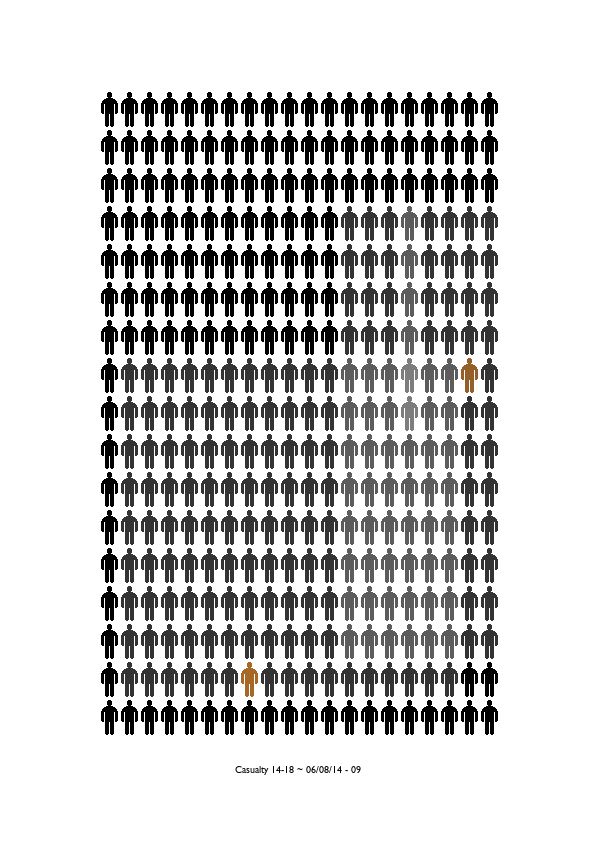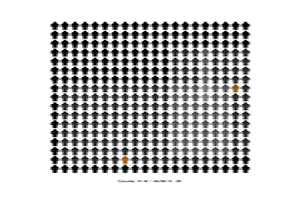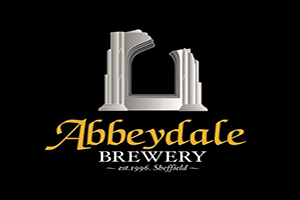
It’s almost a year into four-year art project Casualty 14-18, and the poignant work continues to strike an emotional chord, with new images being produced on a weekly basis. The project was created by Richard Bolam, as a commemoration the 16 million fallen soldiers in WW1. It is currently available to view online, but keep your eyes peeled for future exhibits in and around Sheffield.
Q. Can you tell us a little bit more about where the original idea came from?
The earliest reference I can find in my notebooks is from 2001. I have always been fascinated by information graphics and remember looking at casualty charts of World War One when I was a child. Even then I was appalled by the scale of the tragedy although found it difficult to imagine.
The original idea was not specific to WW1 but was an attempt to make a statement about equality in death, specifically tragic, violent death. At first I created a range of figures to represent men, women, youths and children. I also intended to vary their sizes and shapes, and have some of them missing limbs, but in this version of the work I decided to use a single image of an adult male figure that represents any single human being.
Q. How is this project personally important to you?
I have always been fascinated by the scale of WW1 and WW2 and, although I have no personal connection beyond family members being in the armed forces, it has been something of an obsession that has cast a longer emotional shadow as I have got older. I hesitated to initiate the project for a long time, but the centenary of WW1 galvanised me into action and I had to swallow any doubts, otherwise I would have missed the opportunity.
Q. In total, the project will last over four years – how do you feel about committing yourself to one idea for such a long period of time?
I worried a lot about it, but I designed the work (in a technical sense) to make it feasible both technically and financially, as well as the time commitment. The online version is created in 7 day batches because I will continue to develop the software in order to introduce more variations. In one sense, the length of the project takes some of the pressure off because I can experiment and develop it, but also create batches of posts for periods when I can’t dedicate any time to it.
Q. Do you think the repetition of so many figures lessens the importance of the individual or emphasizes it?
This is the big challenge of the project. I decided to make a single figure for each military and civilian death for every single casualty of every nation, but the practicalities of representing 16,000,000 individuals is quite daunting. I decided to introduce the subtle colour variations to imply different races, gender, affiliation and roles in order to imply individuality to the figures despite the huge number.
Q. Unlike most visual art, algorithmic art is created and designed by technology, with limited human input. Would you still consider yourself an artist?
It is most definitely art and I am definitely an artist. I would be critical of the vast majority of algorithmic and computational art for being primarily demonstrations of technique rather than art. I chose the method in order to enable the work.
Q. Your website contains every image generated for Casualty 14-18. How does your work translate online, in comparison to in the flesh?
The online work is a version of the work and is appropriate to the virtual space and the timescale it takes to complete. The physical installation was appropriate to a different kind of space, but it is still the same work. A few years ago, I decided to treat all artworks as not “finished” but a current “finished version”. This makes it much easier to think of how an idea might be realized in media or spaces and allows it to develop and not be set in stone at any specific time.
Q. What has been the response to the project so far?
I have had a mixture of responses, some very positive, some puzzled and some indifferent. It is intentionally a stealth effect, a minimal and subtle effect that is intended to dawn on the audience, not be fully understood immediately.
The office and information graphics aesthetic emerged organically, but it has become part of the work. The A4 paper size, the reams of paper, the desk and chairs, and the familiar blandness of the figure but the implied scale is intended to sneak up on the audience.
https://casualty1418.wordpress.com/
Words: Melissa Fawcett
Image © Richard Bolam



